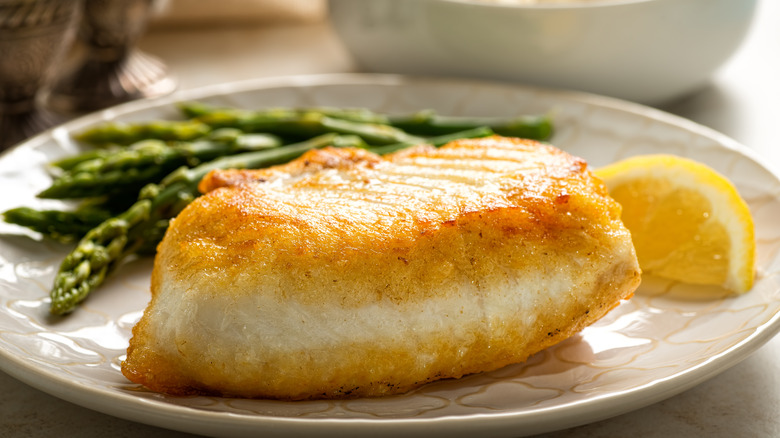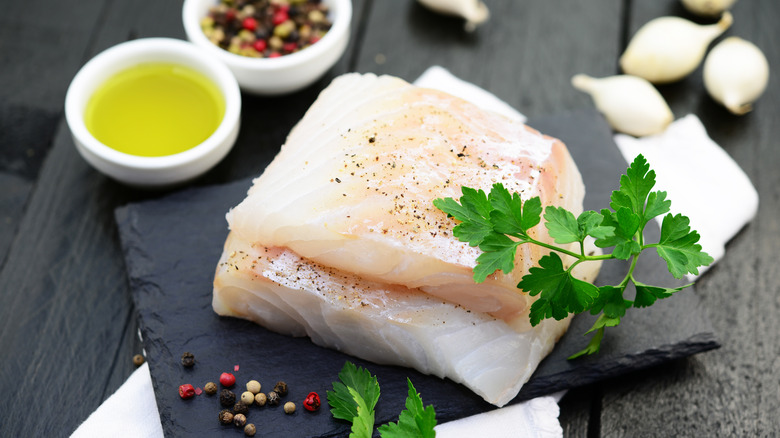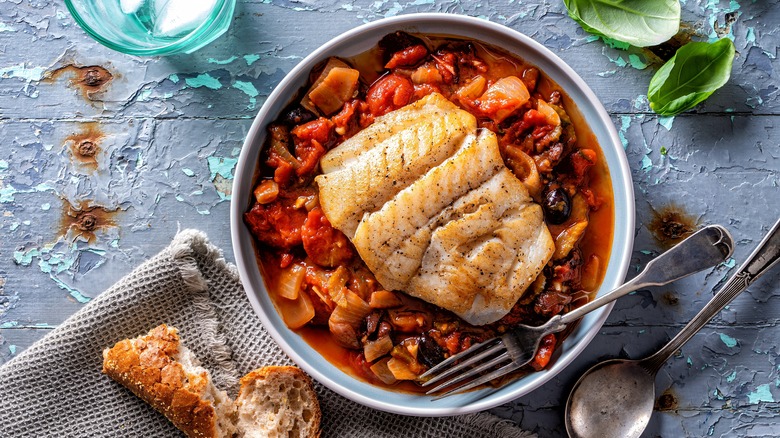The Best Way To Cook Halibut For A Bright And Buttery Finish
When it comes to cooking fish, halibut stands out as a versatile option that can easily elevate your culinary repertoire. With its firm, white flesh and mild yet slightly sweet flavor, halibut offers a canvas for creativity. Much like with any fish, though, unlocking its true potential requires the right techniques to ensure a moist, delectable filet that isn't dry and mealy.
Halibut, a cold-water flatfish found in both the North Pacific and North Atlantic, boasts a flavor profile that leans towards a delicate sweetness. Its meaty texture lends itself well to various cooking methods, but pan-searing is a go-to technique to showcase its qualities. The challenge lies in preserving its moisture while enhancing its taste. Quick pan-searing over medium-high heat is the key, and butter becomes the secret weapon to achieve the perfect rich glaze on the fish.
But butter alone can be a bit heavy-handed. As with any dish, balance is key, and the best counter to overt richness is sharp acid. There are, of course, many ways to go, but for this introduction, we're leaning into classic seafood cookery. That means butter and lemon, a match made in heaven that works well with everything from salmon to lobster.
How to cook halibut to retain it's juiciness and create a burst of flavor
Start by selecting fresh halibut filets with a glistening appearance and a mildly oceanic scent. Pat them dry with a paper towel to ensure a crisp sear. Season the filets generously with salt and pepper, and rest in a refrigerator to allow the seasoning to penetrate the flesh. In a skillet, heat a generous amount of butter over medium-high heat until it sizzles and foams.
Carefully place the halibut filets into the skillet, presentation side down, allowing them to make direct contact with the heat. This initial contact is essential for creating a golden-brown crust that locks in the halibut's moisture. Let them cook undisturbed for about three to four minutes, resisting the urge to fiddle with them. Gently flip the filets using a spatula, revealing the beautifully seared side.
Now, here's the trick to preserving the juiciness and introducing a burst of flavor — squeeze fresh lemon juice over the filets. The natural acidity of the lemon not only adds a bright contrast but also prevents the halibut from drying out during the final moments of cooking. Continue cooking for an additional two to three minutes, allowing the lemony aroma to infuse the fish.
Flavors beyond using just butter and lemon
While the classic butter and lemon combination undoubtedly creates a delightful finish, there are plenty of exciting ways to riff on the combination of fat and acid. The halibut's delicate flavor has its pros and cons that must be taken into consideration. While it is a wonderfully open protein that supports stronger flavors, being too assertive with them will only serve to mask the pleasantly-mild fish. For halibut, a deft and moderate hand in seasoning is critical.
For herb-infused elegance, substitute butter with high-quality extra-virgin olive oil. Enhance the dish by adding a medley of fresh herbs like cilantro, oregano, or tarragon to the skillet. As the halibut sizzles, the fragrant herbs will infuse their essence, imparting a harmonious symphony of flavors. You may also want to elevate the fish with the aromatic allure of minced garlic, shallots, or even finely sliced onions. Sauté these aromatics in butter or olive oil before adding the halibut to the skillet.
While lemon is a classic choice, consider experimenting with other acidic ingredients. Thinly blood orange juice, a splash of white wine, or a drizzle of balsamic vinegar can lend a unique tang to your halibut. Outside of acid, one can take inspiration from global cuisines by incorporating spices and sauces like harissa, dukkah, or za'atar. These exotic flavors can harmonize surprisingly well with halibut's mild taste, giving you a taste of culinary fusion.


